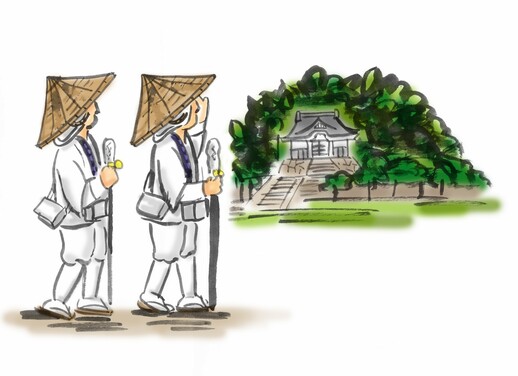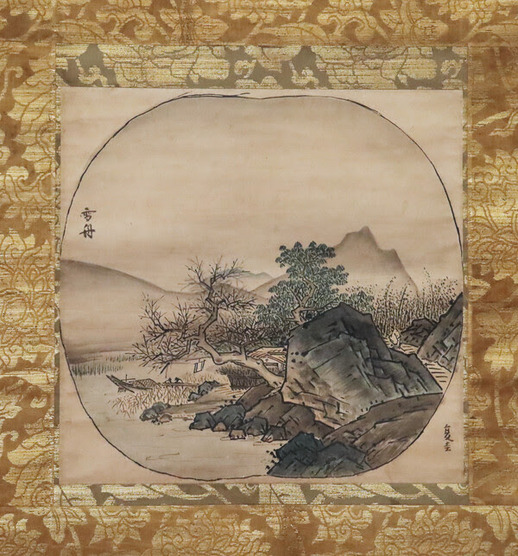「和」を知る・「和」を楽しむ・「和」を伝える日本のスペシャリストになろう!
週刊メールマガジン「伝検通信」第39号をお届けします。本年最後の通信です。
今週のトップ記事は、伝統工芸の継承の在り方を巡る問題提起です。超絶技巧を誇りながら歴史の正当な評価を得られていない金工家たちにスポットを当て、国としてやるべきことは何かを問います。外国で評価されて初めて自国の文化の魅力に気付くようでは、確かに「貧しい国」と言わざるを得ません。年末年始の休暇中にじっくり考えてみたいテーマです。
「クイズで肩慣らし」は、前回クイズの答え・解説と、風習に関する問題です。1月末までの第1回検定期間中は同試験の出題対象から外し、伝統文化に関するさまざまな問題をお届けします。
現在実施中の2級および3級の第1回伝検の受験は下記サイトから申込みできます。公式テキスト、2級受験者向けオンライン講座も販売しています。
伝検申込サイト https://denken-test.jp/
目次
・ 宙ちゃんの「伝統文化一直線」 第15回 貧しい国
・ 「クイズで肩慣らし」第38回=「風習」
・ 伝検協会だより
宙ちゃんの「伝統文化一直線」 第15回 貧しい国
近藤宙時=日本伝統文化検定協会理事

世界を魅了した明治期の銀製ケース(左:藤井美豊作、右:池戸民国作)
戦争は技術を生み出し、平和がそれを進化させるといわれます。日本でも、戦を生業(なりわい)とする武士階級が支配した鎌倉時代から戦国時代にかけて、今に続く工芸の多くが鎧(よろい)兜(かぶと)、刀剣といった武具から起こり、平和な徳川の治世になって美をまといました。例えば、印伝(鹿の皮に漆などで模様を付けた工芸品)は武士が身に着けるすね当てや小手、陣羽織などの戦装束から、また簪(かんざし)などの装飾品は鍔(つば)や目貫(めぬき)、笄(こうがい)、小柄(こづか)などの刀装具から生まれ、極めて高度な技術に発達したものです。
江戸から明治への時代の転換は、工芸の世界に大きな衝撃を与えました。とりわけ深刻な影響を受けたのが、刀剣や鎧兜などの武具の制作に携わっていた金工師たちです。武士階級という唯一の顧客を失った彼らは、路頭に迷いながら、シガレットケースや名刺入れ、コンパクトケースにカフス、ペンダントなどの装身具、花瓶や香炉などの家庭用品の制作に活路を見いだしていきました。
明治政府は当時、工芸品を輸出の主力と位置づけ、その伝承、発展を推進していました。20円金貨や1円銀貨の原型制作で知られる加納夏雄や、重要文化財「蘭陵王置物」などの作品を残した海野勝珉(うんの・しょうみん)ら、帝室技芸員に指定された工芸家たちの経歴や業績はインターネットで簡単に調べられます。
しかしながら、それ以外の工芸家となると、全くと言っていいほど記録が残っていません。金工の正阿弥勝義や牙彫(げちょう)の安藤緑山(ろくざん)、陶芸の宮川香山(こうざん)など、ごく一部の人物に関しては、近年、京都の清水三年坂美術館の努力によって業績が研究され、記録も整ってきましたが、その他の工芸家については手付かずのままです。
写真左の銀製ケースを制作した藤井美豊は、1910年にロンドンで開かれた日英博覧会で金賞を獲るなど数々の展覧会で受賞。天皇お買い上げの栄誉にも浴したほか、象嵌(ぞうがん)技法に関する特許を得て200人以上もの職人を雇って工房を運営し、多くの作品を輸出しました。写真右の銀製ケースの作者である池戸民国は刀剣の鍔や目貫の制作で名声を得ていましたが、明治維新後は装身具や香炉などの民生品に転じ、その技術力の高さと芸術性からボストン美術館にもブースが設けられているほどです。ただ、両人の名前をネットで検索しても、ヤフーオークションの出品物が出てくるくらいで、生没年すら載っていません。
ところが、「Fujii Yoshitoyo」「Ikedo Minkoku」で検索すると、英文では生没年はもちろんのこと、上記の事績を含め、かなり詳細な情報が表示されます。工芸の中で主流の位置を占める金工の世界でさえこの状況ですから、他のジャンルも似たようなものでしょう。思えば、この国は北斎、広重から白髪一雄、草間彌生、村上隆に至るまで、自分たちでは評価すらできず、他国にその素晴らしさを教えてもらってきた国でした。
工芸の世界は、油絵や日本画などの芸術系以上に、より日本の伝統文化、日本という国の個性・魅力に深い関わりを持っています。本来は国立の博物館・美術館、あるいは文部科学省に少なくとも明治以降の工芸を網羅したリストがあるべきです。残念ながら、日本の伝統工芸を包括的に研究し、工芸家やその作品のリスト化はもちろん、彼らの技法・技術について映像も含めたアーカイブを作って次の時代に伝える機関はどこにもありません。これではとても文化的に豊かな先進国とは言えず、「貧しい国」と言わざるを得ません。あまりにも寂しい話です。
手をこまねいているうちに失われてしまった貴重な技法・技術も少なくありません。失ってしまってから、それらを「幻の技法」と呼んで尊ぶ状況は、本来あってはならないことです。国が何もせず、江戸時代に失われた志野焼を長年の努力で再現した荒川豊蔵のような稀有な人物の出現を神頼みしているようでは、世界の笑いものになるだけでしょう。
伝統工芸は、この列島に人が住み始めて以来、生々流転しながら、日本という国を日本らしく魅力的なものにしてきた伝統文化を目に見える形で今に伝えてくれています。いわば、日本の華です。花に水の一つもやらない国であってはなりません。伝統工芸・伝統文化に関する情報の発信だけでなく、その継承・発展に日本伝統文化検定協会が少しでも寄与できたらと切に思います。
「クイズで肩慣らし」第38回=「風習」
~第1回検定期間中のクイズは同試験の出題対象から外します。またテキストの分野以外からも取り上げます~

四国八十八カ所霊場を巡礼するお遍路(イラスト)
第38回
問題:四国八十八カ所霊場を巡礼するお遍路は江戸時代から庶民にも広まりました。お遍路中の基本的な服装は白衣(はくえ)・輪袈裟(わげさ)・金剛杖(こんごうづえ)に菅笠(すげがさ)ですが、白衣や菅笠に書きつける四字熟語は何でしょうか。(答えと解説は次号で)

雪舟「倣夏珪(ほうかけい)山水図」
【前回の問題と答え・解説】
問題:「山水画」「人物画」と並ぶ、水墨画の三大画題は何でしょうか。
答え:花鳥画
解説:水と墨で濃淡をつくって描く水墨画は、中国の山水画の技法が日本に伝わったもので、鎌倉時代、禅の教えとともに、当時の武士の精神に合い広く受け入れられるようになりました。水墨画の3大巨匠としては、雪舟(せっしゅう)、牧谿(もっけい)、探幽(たんゆう)が有名です。
伝検協会だより
▼伝検の学習分野でもある浮世絵の作品を基に制作されたデジタルアートを楽しめる「動き出す浮世絵展 TOKYO」が12月21日に、寺田倉庫G1ビル(東京都品川区)で始まりました。伝検協会会員の時事通信社が同展実行委員会に加わっており、開催期間は2025年3月31日までです。同展は3DCGアニメーションやプロジェクションマッピングを駆使した立体映像空間で浮世絵の世界に没入できる体感型ミュージアムで、大人から子どもまで楽しめます。同展の浮世絵ナビゲーターを務めるタレントの堀口茉純さんは19日の事前イベントで「面白いと思える作品はきっとあると思う。浮世絵の世界を楽しんでほしい」と話しています。
▼石川県金沢市で江戸時代の文政5年(1822)以来、創業200年を超える九谷焼の窯元、鏑木商舗から検定の合格者特典をご提供いただきました。本店「金沢九谷ミュウジアム」(金沢九谷ミュウジアム | 鏑木商舗)の来店者に合格認定証の提示で商品10%引きと、ご当地アイス菓子のマルガージェラ―ト(シングルサイズ)贈呈です。詳細は公式サイトの合格者特典をご覧ください。
▼伝検公式テキストの電子書籍版につきまして、
▼協会事務局は12月28日(土)から来年1月5日(日)まで、年末年始で休業となります。皆さま、よいお年をお迎えください。
編集後記
今年最後の伝検通信をお届けしました。今年の正月休みは最大9連休になるため、普段行けない遠くへの旅行や家でのんびりするなど、有意義な時間を過ごす予定の方も多いかと思います。ぜひ休みの間に公式テキストなどをお手に取って伝統文化・伝統工芸の世界に触れてみてください。新年最初の本通信は年明け1月9日に配信予定です。皆さま、どうかよいお年をお迎えください。
【English version】
Weekly e-mail magazine “DENKEN TSUSHIN” No. 39
We are pleased to present the 39th issue of our weekly e-mail newsletter “DENKEN TSUSHIN”. This is the last communication of the year.
This week’s top article raises the issue of how traditional crafts should be handed down. It spotlights goldsmiths who boast superb craftsmanship but have not received due historical recognition, and asks what we as a nation should do about it. If a country does not realize the appeal of its own culture until it is recognized by foreign countries, it must certainly be called a “poor country. This is a theme I would like to think about carefully during the year-end and New Year vacations.
The “Let’s Practice with Quizzes” section contains answers and explanations to the previous quiz, as well as questions related to customs.
The first DENKEN exam for Level 2 and Level 3, which is currently being conducted, can be applied for at the following website. Official textbooks and online courses for Level 2 examinees are also available.
DENKEN application site: https://denken-test.jp/examination/
Table of Contents
・Chu-chan’s ““Traditional Culture in a Straight Line” No.15 Poor Country
・Quiz to familiarize yourself with the culture” No.38 = ”Customs
・From the Dendo Kensa Kyokai
Chu-chan’s “Traditional Culture in a Straight Line” No. 15 Poor Country
Kondo Chuji = Director, Japan Traditional Culture Certification Association

Meiji era silver cases that fascinated the world (left: by Yoshitoyo Fujii, right: by Minkoku Ikedo)
It is said that war creates technology, and peace evolves it. In Japan, from the Kamakura to the Sengoku periods, when the warrior class, whose livelihood depended on warfare, dominated the country, many of the crafts that continue to this day originated in armor, helmets, swords, and other armors, which became beautiful in the peaceful reign of the Tokugawa shogunate. For example, inden (deer skin with lacquer patterns) came from war costumes worn by warriors, such as shinpatsu, kote, and jinbaori, and ornaments such as kanzashi came from sword accessories such as tsuba, menuki, kougai, and kogara, and developed into extremely advanced techniques.
The transition from the Edo period to the Meiji period (1868-1912) had a profound impact on the world of crafts. Particularly severely affected were the goldsmiths who were involved in the production of swords, armor, and other armors. Having lost their only clientele, the samurai class, they found their way to the streets, producing cigarette cases, business card cases, compact cases, cufflinks, pendants, and other accessories, as well as vases, incense burners, and other household items.
The Meiji government at the time considered crafts to be the mainstay of exports and promoted their transmission and development, and the careers and achievements of craftsmen designated as Imperial Household Artists, such as Natsuo Kano, known for his prototype production of the 20 yen gold coin and 1 yen silver coin, and Shomin Unno, whose works include the important cultural property “Ornament of the King Lanryo” can be easily found on the Internet. The biographies and accomplishments of craftspeople designated as Imperial Artists, such as Unno Shomin, who produced works such as the important cultural asset “Lanryo Royal Ornament.
However, for other craftspeople, there are almost no records at all. In recent years, thanks to the efforts of the Kiyomizu Sannenzaka Museum of Art in Kyoto, the achievements of a small number of craftsmen, such as Shoami Katsuyoshi (metalworker), Ando Rokuzan (carver), and Miyagawa Kozan (ceramic artist), have been studied and documented, but other craftsmen remain untouched.
Fujii Yoshitoyo, the creator of the silver case on the left, won numerous awards at exhibitions, including a gold medal at the 1910 Anglo-Japanese Exposition in London. He was also honored by the Emperor of Japan with a purchase order. He was granted a patent for his inlaying technique, employed over 200 craftsmen to run his workshop, and exported many of his works. Ikedo Minkoku, the maker of the silver case on the right of the photo, gained fame for making sword tsubas and menuki, but after the Meiji Restoration, he turned his attention to consumer items such as ornaments and incense burners, and even has a booth at the Museum of Fine Arts, Boston, for his high skill and artistic merit. However, when searching for the names of both artists on the Internet, only Yahoo! Auctions items come up, and not even their dates of birth and death are listed.
However, if you search for “Fujii Yoshitoyo” or “Ikedo Minkoku,” you will find quite detailed information in English, including the birth and death dates as well as the above achievements. Since this is the situation even in the world of metalwork, which occupies a mainstream position among crafts, other genres must be similar. Looking back, this is a country that has been unable to even appreciate its own works, from Hokusai and Hiroshige to Kazuo Shiraga, Yayoi Kusama, and Takashi Murakami, and has had to rely on other countries to teach it how to appreciate them.
The world of crafts is more closely related to traditional Japanese culture and the individuality and charm of Japan as a country than to oil paintings, Japanese-style paintings, and other art forms. Originally, national museums and art museums, or the Ministry of Education, Culture, Sports, Science and Technology, should have a comprehensive list of crafts from at least the Meiji period onward. Unfortunately, there is no institution that comprehensively researches traditional Japanese crafts and creates a list of craftsmen and their works, as well as an archive of their techniques and skills, including videos, to pass them on to the next generation. This is not a culturally rich developed country, but rather a “poor country. It is a very sad story.
There are many valuable techniques and skills that have been lost because we have not done anything about it. It is not right to call them “phantom techniques” after they have been lost. If the government does nothing, and instead relies on the emergence of a rare person like Toyozo Arakawa, who worked hard for many years to recreate Shino Yaki that was lost during the Edo period, it will only become a laughingstock of the world.
Traditional crafts have been a part of the traditional culture that has made Japan attractive and unique since the beginning of human habitation in this archipelago, and they have been passed down to us in visible form. They are, so to speak, the flowers of Japan. Japan should not be a country that does not water its flowers. I sincerely hope that the Japan Traditional Culture Certification Association can contribute not only to the dissemination of information on traditional crafts and culture, but also to their inheritance and development.
Let’s Practice with Quizzes No. 38 = ”Customs
~Quizzes from the 1st certification period will not be included in this examination. Also, the quizzes will be taken from areas other than those covered in the textbooks.

Pilgrimage to 88 sacred places in Shikoku (Illustration)
The 38th
Question: The pilgrimage to the 88 sacred sites of Shikoku became popular among the general public during the Edo period (1603-1868). The basic attire worn during the pilgrimage is a hakue (white robe), wagesa (monk’s robe), kongozue (walking stick), and sugegasa (sedge hat). (See the next issue for the answer and explanation.)

Sesshu “Landscape with Houkakei
Previous Question and Answer / Explanation
Question: What are the three major subjects of ink and wash painting, along with “landscape painting” and “portrait painting”?
Answer: Flower-and-bird painting
Explanation: Suiboku-ga, which uses water and ink to create shading, was introduced to Japan from the Chinese landscape painting technique. The three most famous ink painting masters are Sesshu, Mokkei, and Tan’yu.
From Denken Kyokai
▼ On December 21, the “Ukiyo-e in Motion Exhibition TOKYO” opened at the Terada Warehouse G1 Building (Shinagawa-ku, Tokyo), where visitors can enjoy digital art created based on Ukiyo-e works, which is also a field of study for Denken. Jiji Press, a member of the DENKEN Association, is a member of the exhibition committee, and the exhibition will run until March 31, 2025. The exhibition is a hands-on museum where visitors can immerse themselves in the world of Ukiyo-e through a three-dimensional visual space that makes full use of 3DCG animation and projection mapping, and can be enjoyed by adults and children alike. At a pre-event event held on January 19, the exhibition’s Ukiyo-e navigator, the celebrity Maazumi Horiguchi, said, “I am sure that there will be works that you will find interesting. I hope you will enjoy the world of Ukiyo-e.
▼ Kaburaki Shoho, a Kutani-yaki potter in Kanazawa City, Ishikawa Prefecture, which has been in business for over 200 years since 1822 (Bunsei 5) during the Edo period, has offered special benefits to those who pass the certification test. (1) Visitors to the main store “Kanazawa Kutani Museum” (Kanazawa Kutani Museum | Kaburaki Shoho) will receive a 10% discount on merchandise and a single-size Margar Gelato, a local iced cake, upon presentation of the certification card (2) 10% discount on merchandise at the online store upon sending an image of the certification card (3) 10% discount on merchandise at the Kaburaki Shoho store upon presentation of the certification card (4) 10% discount on merchandise at the Kaburaki Shoho store upon sending an image of the certification card (2) 10% discount for sending an image of the passed certification card to the online shop. For details, please refer to the official website for the benefits for successful applicants.
▼ The e-book version of the official text of Denken Official Textbook went on sale on December 26. If you would like to purchase it, please click here (DENKEN Official Textbook – JIJI Press Publishing Bureau).
▼ The JIA office will be closed from December 28 (Sat.) to January 5 (Sun.) for the year-end and New Year holidays. We wish you all a Happy New Year!
Editor’s Postscript
This is the last DENKEN newsletter of the year. This year’s New Year holiday will be up to nine consecutive days off, so many of you may be planning to spend some quality time travelling to far-away places you wouldn’t normally go, or relaxing at home. We hope that you will pick up the official texts and other materials and get in touch with the world of traditional culture and traditional crafts during the holidays. The first edition of this newsletter for the New Year will be distributed on 9 January. We wish you all a very happy new year.





